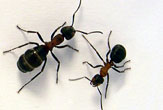
Many insects go back and forth between their nests and a food source multiple times. But if the route to the food is very similar to the route away from it, then the foragers might get confused and not know which way to go.
Different insects have different ways of dealing with this problem. Bees use the Sun as their compass. But ants use visual landmarks and let their stomachs guide their way, a new study finds.
Wood ants were trained to walk in a straight line alongside a black wall to reach a sugar reward at the other end. In this way, the ants learned that the wall would be on their left side when walking towards the sugar but on their right side when walking away from it back home. The distance between home and the sugar reward was about 3 feet.
Later, the trained ants were set down midway along the wall and watched to see which way they would go. Some of the ants had already been fed while others were hungry.
The ants that already ate didn’t need the sugar so they headed home, keeping the black wall on their right. Meanwhile, those that were hungry headed towards the sugar, keeping the wall on their left.
Even when the wall was rotated, the ants had no trouble figuring out which way they needed to go, illustrating that compass directions had no effect on their decisions.
In a variation of the experiment, the researchers placed the trained ants in the middle of two black walls, one on their left side and one on their right. But even in this case, the unfed ants walked closer to the right wall when fed and closer to the left wall when unfed.
Sign up for the Live Science daily newsletter now
Get the world’s most fascinating discoveries delivered straight to your inbox.
The experiment, detailed in the Nov. 17 issue of the journal Nature, gives insight into how social insects like ants and bees distinguish between complex sets of memories.
“Being able to store lots of memories is not much use unless you also have mechanisms for retrieving the appropriate memory when you need it,” said Rob Harris, a researcher at the University of Sussex in Britain who was involved in the study.
- Ants Ambush Prey from Foxholes
- Dancing Bees Speak in Code
- Ants 'Fly' When They Fall
- Gallery: Invasive Species









